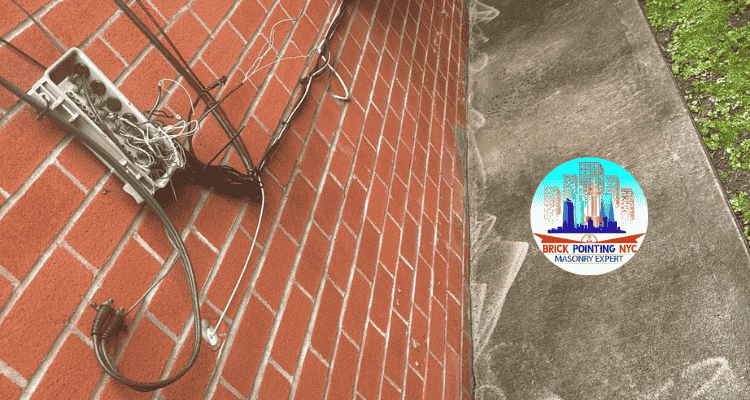Brick pointing makes your home look sharp, but let’s be honest, that’s just the cosmetic side of things. Brickwork is your home’s armor against water leaks, structural problems, and repairs that can cost a fortune. And if you live in Long Island, your bricks are under even more stress from salty air, harsh winters, and coastal storms.
Here’s the thing: damage often creeps up quietly. You might spot a hairline crack, some white residue, or a small damp patch and shrug it off. Meanwhile, water slips in, bricks start loosening, and before you know it, your wall’s fighting a losing battle.
We’ve seen homeowners get blindsided because they didn’t notice these subtle warnings in time. It’s why we always say, learn the quiet ways your home might be asking for help. Spot these signs early, and you can save yourself thousands in repairs and keep your walls standing strong for decades.
So, how do you know if your brickwork is waving a red flag? Let’s look at the silent signals that mean your brick pointing in Long Island needs attention right now.
Silent Warning Signs Your Long Island Home Needs Brick Pointing Right Now
1. Hairline Cracks in Mortar Joints
Tiny cracks between bricks might seem harmless, like part of the wall’s natural aging. But don’t be fooled. Those little fissures are sneaky pathways for moisture. And in Long Island, where winters bring freeze-thaw cycles, water inside those cracks expands and contracts, gradually prying them wider. We’ve watched small cracks turn into loose bricks over a single winter. Once bricks start shifting or popping out, your wall’s structure is at risk, and repair costs skyrocket. That’s why it’s smart to call a masonry contractor Long Island homeowners trust as soon as you see even hairline cracks.
2. White, Chalky Residue on Bricks (Efflorescence)
Have you ever walked past your brick wall and noticed a white, powdery film? That’s efflorescence, the mineral salts left behind when water evaporates from your bricks or mortar. People often assume it’s just a cosmetic annoyance. The truth is, it’s like your bricks flashing a warning light. Efflorescence tells you water is moving through places it shouldn’t. Over time, that moisture can break down the mortar, leaving it soft and crumbly. If you keep scrubbing off white residue only for it to return, that’s your cue to look deeper. You might need brick pointing Long Island to stop water in its tracks.
3. Mortar Falling Out or Missing Completely
Here’s a sign you can’t miss; run your hand along your brick wall. Feel gaps, loose bits, or chunks of mortar falling out? That’s not normal wear and tear; it’s a red alert. When mortar disappears, your bricks lose their support. Water can slip behind the wall, rotting wooden structures, rusting metal supports, or even causing interior leaks. We’ve seen entire brick sections start leaning because mortar vanished unnoticed. Don’t wait for bricks to start tumbling out. A skilled masonry contractor in Long Island can restore your mortar joints through brick pointing and keep your walls solid and safe.
4. Damp Spots or Interior Water Damage Near Brick Walls
One of the sneakiest clues that your brickwork needs help is water damage inside your house without any obvious source. Our experts have walked into homes where paint was peeling, drywall was stained, or a stubborn musty smell lingered, and the cause turned out to be crumbling mortar outside. Once it seeps through weakened mortar joints, it slips behind your brickwork and attacks insulation, wood framing, and finishes. If you’re dealing with random leaks, damp spots, or unexplained water damage near exterior brick walls, don’t just patch it up inside. It could be time for brick pointing in Long Island home to keep moisture where it belongs, outside.
5. Bricks Shifting or Bulging Outward
Of all the signs on this list, shifting or bulging bricks are the ones that make the stomach drop. Water penetration weakens mortar, and once that happens, bricks can slip under pressure from the weight of the wall or freeze-thaw forces. I’ve seen walls bow out like a ripple in a rug. And if left unchecked, sections of that wall could collapse entirely, putting people and property in real danger. If you spot bricks shifting or bulging, call a masonry contractor Long Island immediately. Long Island specialists know how to assess the damage and reinforce your walls before things get worse.
Conclusion
Here’s what it all comes down to: brick walls are tough, but their mortar joints won’t last forever. Those silent signs we’ve talked about are your chance to act before small issues snowball into big disasters. If you’ve noticed hairline cracks, white residue, missing mortar, damp spots, or shifting bricks, don’t brush it off. Call a masonry contractor Long Island homeowners rely on and ask about brick pointing services. It could be the difference between a quick fix and a major rebuild, and it’ll keep your home standing strong and beautiful for years to come.


